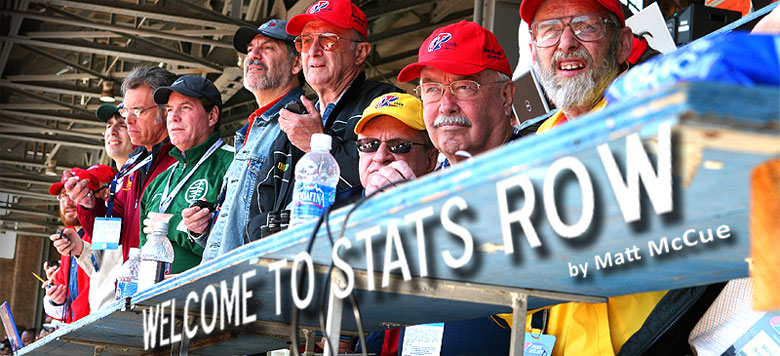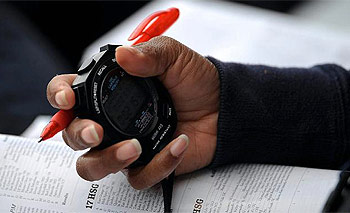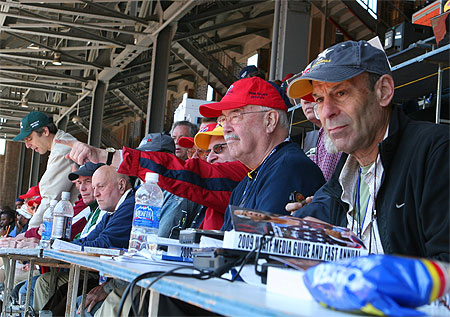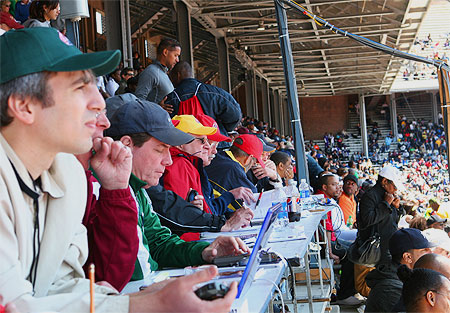 |
 |
 |
|
|
 |
 |
 |


| | Photo by John Nepolitan / >> Matt McCue ARCHIVES | The Penn Relays are steeped in tradition and history. From the whoots coming off the famous far turn to the funnel cake for sale under the backstretch grandstand, you can't step into Franklin Field the last weekend in April without being awash in the sights and sounds of a great American track meet. This year, we asked Matt McCue to spend some time with one of the enduring-- and invaluable-- hallmarks of the Penn Relays, the amiable committed curmudgeonly argumentative precise persistent passionate hilarious group known as 'Stats Row." Have a seat.
|
|
 | Photo by Kirby Lee, imageofsport.com
|
Parked in the best row in the house, 18 steps directly above the start/finish line at the University of Pennsylvania’s Franklin Field, Jack Pfeifer, the bearded sage of the Penn Relays ace stats crew, addressed his fellow volunteers fanned out across the chilled metal bleacher.
"Give me your team in 174," he said, pointing his pen down the row at the ten statisticians leaning over their makeshift wooden counter strewn with slips of white paper, pencils, pens, binoculars, stopwatches, and, for most, rolls of quarters. Whenever I had asked anyone in the press room about the statisticians, they always replied, "Do you know about the game they play with quarters?" When they described the details, it sounded made up. Of course, I would learn, it was all true.
Alive with chatter, the track veterans along the row tossed out letters corresponding to their chosen teams in the first heat of the high school boys’ 4 x 400-meters, section 174, and beginning early at 8:55 a.m.
“A!” “E!” “C!”
“You got it,” replied Jack, marking initials next to team names on the heat sheet.
While waiting for the gun to fire, the statisticians would normally grip their stopwatches tightly, their eyes glued to the school colors of their assigned team. Once the pistol cracked, they’d click their start buttons simultaneously.
Pay The Loser
But it was Saturday morning at the 115th Penn Relays, and Saturday morning at "Penn" means an endless lineup of high school boys’ 4x400 heats. This year, the number totaled 47 mile relays in a row, rushed along in rapid succession, one immediately after the other. The nervous jumble of sprinters chased their one minute of glory, just enough time to be able to say they’ve broken a sweat at the world famous meet. To help keep them entertained during the first three hours of mind-numbing slower heats preceding the faster ones, the statisticians needed a…slight distraction.
|

| Photo by Kirby Lee, imageofsport.com
|
So, they passed the time by partaking in a self-created gentleman’s game. Turning their row into a betting parlor, they placed wagers on each heat like it was the Kentucky Derby. As many as 15 teams were stuffed into each section, sharing lanes at the start and finishing spread out by as much as half a minute from first place to last. It was anyone’s guess as to who would break the tape. Whoever picked the winner of each heat collected a quarter from the others. The most anyone could win on all 47 races was a whopping $11.75. However, there was an ample amount of pride on the line, and that was...priceless.
Paul Limmer, the legendary track and field coach for 33 years at Wellington C. Mepham High School in New York, stood on his feet, shouting the letter of his team rounding the far turn, “E is looking good! E is looking good!”
E was in last place.
This was exactly what Paul had hoped for. See, in this rivalry among friends, there was a unique twist. The winner was not the only person rewarded. The loser also collected a quarter from everyone along the row. It explained why Paul soon began hooting, “Keep fading! Keep fading! Come on baby! I’m last! I’m last!” When his chosen runner pushed ahead into second-to-last-place, Paul rhetorically asked, “What is wrong with him?”
Locked in a dead heat, the two trailing anchors plodded along at 58-second quarter pace. After his team fell back and eventually finished behind the field, Paul was ecstatic. “Yes! Yes! Yes! Yes! Pay up, baby! Pay the loser!”
Gun’s Up!
The characters along stats rows are first and foremost committed track and field fans.
Supporting the sport in various ways throughout the year, they return to the Penn Relays every April for their annual trackside reunion. In the process, they provide a valuable service to the meet—official records for splits captured by reputable timers. While the statisticians take their roles seriously, it’s hardly a silent affair. When they’re not joking or ribbing each other, they’re constantly asking, Did you see that time? Wow! He just split 45.7! Their race analysis is driven by a passion, and appreciation, for jaw-dropping performances; their liberal use of exclamation points punctuates every comment. Amid the nearly 50,000 people in attendance, it looks like they’re having the most fun out of anyone.
Don’t be fooled by the nerdy-sounding term statistician, calling to mind images of people taking surveys in windowless rooms. The names of this veteran fraternity are visionaries who have significantly helped youth track and field grow and evolve. To list a few: Bob Hersh, a lawyer by trade, was a longtime meet announcer. He has called six Olympic Games and currently sits as the Vice President of the IAAF. This year, the Penn Relays named him an honorary carnival referee. Jack Pfeifer, a former national editor at The New York Times, is the Director of College Track at the New York Armory in Manhattan. John C. Blackburn, a chemical engineer, was one of the youngest track officials at the 1996 Atlanta games.
|

| Photo by John Nepolitan
|
Jim Spier and Mike Byrnes co-founded the National Scholastic Sports Foundation. A.J. Holzherr, the Director of Business Development for the NSSF, recruits the athletes for Nike Indoor Nationals and Nike Outdoor Nationals. A world-renowned lily breeder, Paul Limmer is on the NSSF Board of Advisors. Joy Kamani, the only female on the Row, is on the Board of Directors for the NSSF. She is a lawyer as well as a proud track mom. Her son is Bayano Kamani, the two-time Olympian in the 400-meter hurdles.
Bob Jarvis, a retired attorney, has played an instrumental role in the Golden West Invitational. Marc Bloom edits The Harrier and writes for Runner’s World. Arnold Shiffrin, a history teacher at Central High School down the street from Franklin Field, coached the great sprinter William Reed, owner of the high school 300-meter national indoor record. Jack Shepard, the original stats guru, recently published the 51st edition of his indispensable reference book High School Track 2009.
Their backgrounds are as diverse as the states they call home—New York and New Jersey, South Carolina and Pennsylvania, stretching all the way to California and Oregon. Yet every year they make a pilgrimage to the Penn Relays—wouldn’t miss it. Together, they’ve timed in rainstorms and froze on unseasonably cold spring days. They’ve clocked the splits for national records, including the highlight this year—the blistering high school boys’ 4 x 800-meter relay: 7:30.67!
Even if they haven’t seen one another during the past twelve months, the group quickly reconnects. To them, the best introduction isn’t a “Hello." It’s the call of “Gun’s up”.
Sitting with best friends
Hidden behind dark glasses, a blaze of taut bodies whizzing by in front of him, Jack Shepard describes their duties as “part of the conscience of the meet, the eyes and ears of the meet. We correct results every year.” Their main role is to pass the splits on to the meet information office who distributes them to the local press outlets. The statisticians also act as a safety net in case one of the high tech timing devices fails, and they’ve been called upon to double-check the official results when a finish has been questioned. Together, they cast a unified vote for the Athletes of the Meet.
Observing the row in action is analogous to watching a flawless baton exchange. Before every relay race longer than 800-meters, Jack Pfeifer slides up and down the narrow slice of concrete behind the bleacher, handing out assignments. If there is a certain hierarchy about who gets what, it is this: The longer you’ve been around, the more established teams you time.
When a race finishes, they record the results on a half-sheet of crisp white paper, listing each leg and the total time. The sheets are passed to Pfeifer who slips them safely into his chocolate-brown folder stamped with “Junior Nationals 1986.” The statisticians are so knowledgeable that they often correct the meet announcer—who sits five rows behind them—whenever he fumbles a call.
|

| Photo by John Nepolitan
|
Formed in the early 1980’s, Stats Row was founded by Bob Hersh and Walt Murphy, who has since graduated to the ESPN announcer’s booth. There he feeds the play-by-play broadcasters their numbers. Many of the statisticians have been attending the Penn Relays since long before then. Jim Spier first came in 1968 and has only missed two of the past 41 years. “Arnie” Shiffrin has been coming a lot longer—since 1954 when he was a sophomore in high school and competed in Chuck Taylor’s. A.J. is considered one of the new guys and he’s been showing up for 15 years.
Stats Rows has roots that extend all the way up to the top of the Penn Relays. David Johnson, “DJ” as his friends call him, is the Director of the Penn Relays. Wearing a black headset, a tuft of white hair poking out from underneath his Penn Relays ball cap, he was one of the original guys. Throughout the day this year, he kept dropping by. When asked if he’d like to re-join stats row at some point, Johnson replied instantly. “Oh yeah!” he said, adding thoughts on the early years, “I got to sit here with all of my best friends and have the meet wash over me like a tidal wave. Now I’m in the position of controlling the tidal wave.”
Because the close-knit clan self-selects its members there isn’t a set admission criteria. One must have paid their dues. One must get the job done. One must share the love for the smell of the hot sun roasting the rubber; one must see the beauty in a face-scrunching finish-line drive. One is asked to join, and not the other way around.
The irony is that while the statisticians can pick the big names out of crowded pack, most of them were never star high school runners. They were the team managers, the editors of the high school newspaper. They had been told by coaches that they were probably better “writing than running.” But something about track and field spoke to them when they were young and it still whispers in their ear today. Each of them receives an all-access credential for their contribution to the meet, but the consensus is that they would still pay to get in.
A sense of history, a sense of place
The statisticians have an uncanny ability to remember the odd and unique from years past, like the reason why there is not a finishing time listed for Hamilton Collegiate in the 1932 high school boys’ 4 x 440 yard relay. It’s because, back then, the officials only recorded the time for the first place finisher, and the original winner had been disqualified.
However, despite their firm grasp on trivia, they all had a tough time recalling that one defining moment they witnessed firsthand at Franklin Field. Was it Michael Johnson competing in the U.S.A. vs. The World relays? Or Alan Webb anchoring his South Lakes High School team to two relays victories in 2001? Nope. The weather received the most votes. This year’s was unbeatable—the best they can remember. Perhaps, that’s the essence of three days splitting relays. It’s partly about catching that smoking 46.9 anchor leg in race number 205 of the 4x400, but mostly about spending a cloudless day watching a track meet with your best friends. Because, in this group, even the loser can finish ahead.
|
|
|
|
|
|
 |
 |